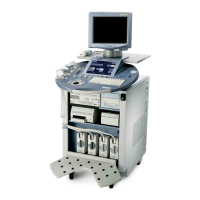GE MEDICAL SYSTEMS - KRETZTECHNIK RAFT VOLUSON® 730PRO / 730PROV (BT´04)
D
IRECTION KTI105947, REVISION 2 SERVICE MANUAL
6-4 Section 6-3 - Monitor Adjustment
6-3-1-3 Contrast and Brightness
Adjusting the monitor´s contrast and brightness is one of the most important factors for proper image
quality. If these controls are set incorrectly, the Gain, TGC, Dynamic Range and even Acoustic Output
may have to be changed more often than necessary to compensate.
The proper setup displays a complete gray scale. The lowest level of black should just disappear into
the background and the highest white should be bright, but not saturated.
NOTE: Brightness and Contrast should be adjusted at examination room light conditions.
Typically values for Contrast and Brightness are 70 to 75, depending on the operator!
1.) Press the MENU
(middle) key (see: Figure 6-1) on the monitor controls
(= toggle button for contrast and brightness).
2.) Adjust the CONTRAST by pressing the LEFT
or RIGHT button to decrease/increase the value.
3.) Press the MENU
key again to toggle to brightness.
4.) Adjust the BRIGHTNESS by pressing the LEFT
or RIGHT button to decrease/increase the value.
6-3-1-4 Geometry
Check the raster lines of the test pattern by referring to Figure 6-2.
Expected results:
1.) Squares are not distorted.
2.) Raster lines are straight.
3.) No keystone and pincushion distortion.
4.) Horizontal and vertical width is correct.
6-3-1-5 Convergence
Check the color of the raster lines (see: Figure 6-2).
Expected result:
Raster lines have only one color.
6-3-1-6 Color temperature
Check the grey scale and the color bars of the test pattern (see: Figure 6-2).
Expected results:
1.) “White“ is displayed without a tint (discolor).
2.) Colors are displayed correctly.
3.) To exit the Monitor Test program, press EXIT
.
6-3-1-7 B-Mode Quality
Connect an abdominal probe (AB or RAB), press the PROBE
key, select the “Abdomen“ application
and start the “Default“ program. Record a B-Image of the liver.
If there is no abdominal probe, record a B-Image of the Thyroid by using a small parts probe
(SP6-12 or SP4-10) and the corresponding program.
Expected result:
Regular and homogenous B-Image without tint.

